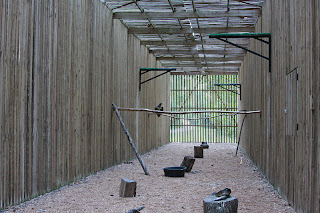In late August our Director, Walter Crawford, received a call from a raptor rehabilitation organization in Wisconsin asking for our help.
Because of the many severe storms and tornadoes in their area this past spring the Wisconsin facility had been inundated with injured and orphaned birds. Some birds came in with the usual injuries and problems, but many were youngsters who had been swept from their nests by the severe storms. Many of these were otherwise healthy, but needed time in the large flight cages to perfect their flying and hunting skills. This large influx of birds had taxed their facility’s holding capacity to the maximum.
This enclosure and the many others at the facility can now be used to their best advantage by shuffling housing arrangements
Because the director of this organization had a longstanding acquaintance with Walter Crawford, our Director, and knew of the World Bird Sanctuary’s excellent reputation as rehabbers and educators, she turned to us for assistance.
REGI staff member Katie Farvour and my husband, Art Schroer, with what looks like a mountain of crates--how will they all fit in the van?
On Labor Day weekend my husband and I headed north to pick up sixteen birds from this organization. The quarters vacated by these sixteen birds would make room for significantly more than sixteen injured and orphaned birds—housing arrangements can sometimes get complicated with animals. Once all the birds were loaded into the van we made a beeline for St. Louis.
The birds begin their journey on a foggy Wisconsin morning
Transporting birds can sometimes be tricky—especially if they are birds that have never been crated before. Some of these birds fell into that category. Our main concern on the drive home was keeping the van cool so that the birds would not overheat. Lunch was definitely a drive through affair, and potty stops were taken in shifts while one person stayed with the birds to keep the air conditioner running. However, all was quiet in the back of the van during the eleven-hour drive and all sixteen of our charges weathered the drive well.
Great care was taken with the birds who were unaccustomed to being crated
As the St. Louis Arch came into view we called ahead to let WBS personnel know that we would be there shortly. To our amazement, when we pulled into the parking area at WBS’s behind the scenes facility we were met by a small army of WBS staff members, including our wonderful volunteer veterinarian Dr. Stacey Schaeffer.
WBS personnel help unload the crates after a safe and successful 11-hour trip from up north
With everyone’s help the newcomers were quickly checked out and their health status and injuries evaluated. The eagles that simply needed flight cage time were released into the large rehab flight enclosure, and the other birds were settled into their new quarters where they would be given time to acclimate themselves to their new surroundings.
All the birds were assessed by our vet and staff members
Our list of passengers included:
• Six possibly releasable Bald Eagles which needed time in a large flight enclosure to allow them to strengthen their flight muscles and perfect their flying skills. As of this date three have been released, the fourth is scheduled to be released next week, the fifth is scheduled to be released on the 29th, and the sixth and final bird is still in the flight cage regaining his flying skills and being conditioned for a successful release.
The six releasable Bald Eagles were released into the flight enclosure to strengthen flight muscles
• Four non-releasable Bald Eagles who may become Education or Display birds
• Two Bald Eagles who have already been trained as education birds and will enhance our existing roster of education birds, either locally or at zoo shows in the coming year.
The education birds who were already wearing "equipment" receive new anklets
• One White Pelican who has a wing injury and cannot fly. This bird has been placed with another injured White Pelican that WBS received about a year ago. Both these birds will be placed with another facility sometime in the not-too-distant future.
• One Rough legged Hawk who was non-releasable due to an eye injury. She had already been trained to the glove and has joined our Education Department. Bella (which means “beautiful”) can be seen in the weathering area behind the Nature Center, and has already begun taking part in education programs.
• Two wing-injured Sandhill Cranes who will be permanent residents of our display line. This pair has in the past laid eggs and it is hoped that they will be comfortable enough in their new surroundings to produce young.















No comments:
Post a Comment